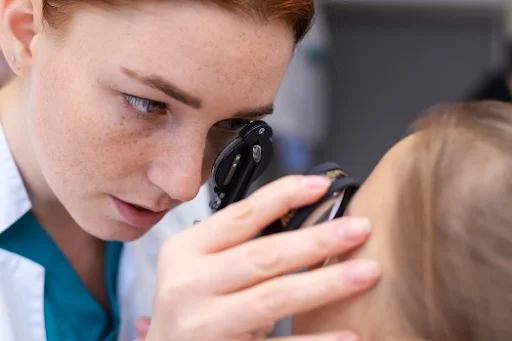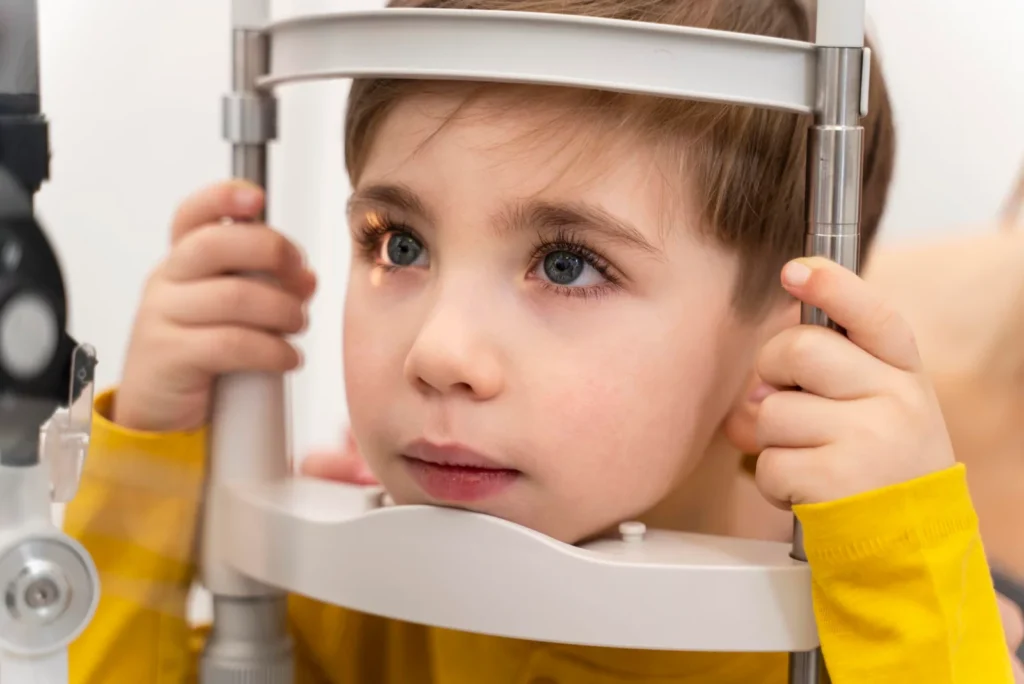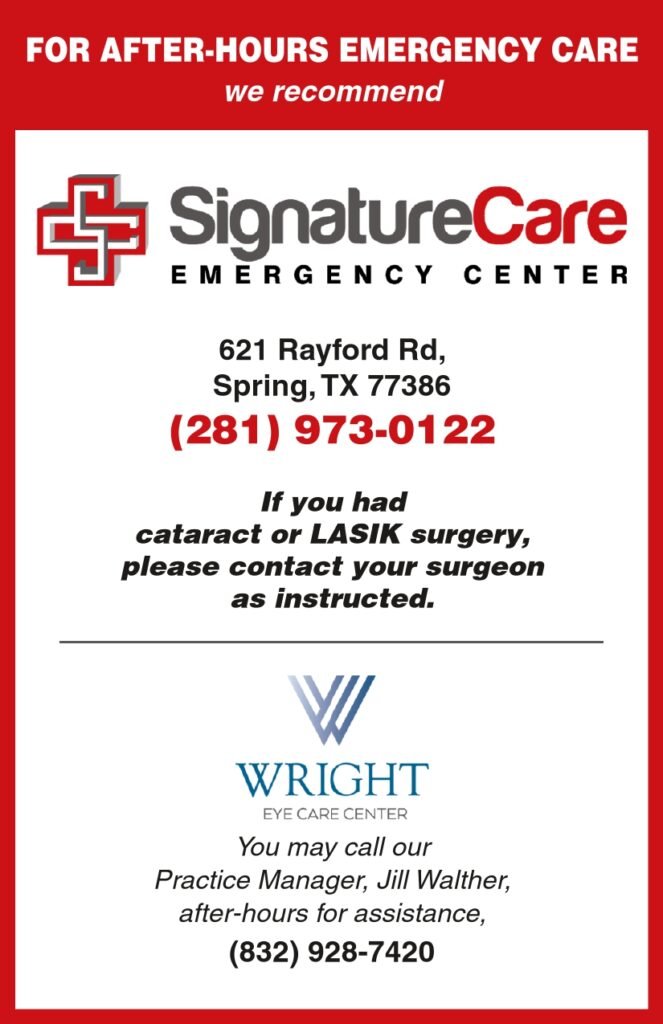

Office Hours: M-Th 8:30 to 5:30, Fri. 8:30 to 3:00
Closed for Lunch: M-Th 1:00 to 2:00






If you’re looking for a clinical examination of the eye, Dr. Wright offers different types of eye exams to evaluate your vision and eye health, including:
Good eye health and vision start with a comprehensive eye exam. Eye exams are just as critical as annual exams with your physician and cardiologist and other medical practitioners you see annually.
A comprehensive eye exam is a clinical examination of your eye. Dr. Wright recommends an annual exam for adults and children starting age 5. For this exam. Dr. Wright inspects your eye’s anatomy and eye health thoroughly. Depending on the initial results of the test, additional testing may be necessary.

For patients who need a basic eye exam to check on specific vision concerns, we can refer to this exam as a “routine eye exam.” What is the difference between a comprehensive eye exam vs. a routine eye exam? A routine eye exam is involves only the vision, pupil, eye movement, and eye pressure tests to assess eye health and look for refractive errors.
A contact lens exam is required to determine your depth perception, visual acuity, and general eye health before contacts can be prescribed. Typically, the appointment includes corneal topography and a tear film evaluation, in addition to the other tests needed for a comprehensive eye exam. You will also show you how to insert and remove your contacts.
Glaucoma is known as “the sneak thief of sight.” There are no symptoms and once vision is lost due to glaucoma, it’s permanent. As much as 40% of vision can be lost without a person even noticing. Half the people with glaucoma do not even know they have it.
There is an epidemic of blindness looming in society today. That is why it is important to raise awareness about the impact of annual eye examinations to preserve your vision.
Glaucoma is a group of diseases that damage the eye’s optic nerve resulting in vision loss and even blindness. Open-angle glaucoma, the most common form, results in increased eye pressure. There are often no early symptoms, which is why half of people with glaucoma don’t know they have the disease.
Although the most common forms primarily affect the middle-aged and the elderly, glaucoma can affect people of all ages. African Americans over age 40, all people over age 60, people with glaucoma in their family history, and those with diabetes are also at a higher risk.
There is no cure for glaucoma—yet. However, medication or surgery can slow or prevent further vision loss. The appropriate treatment depends upon the type of glaucoma among other factors. Early detection is vital to stopping the progression of the disease, preserving your vision and preventing vision loss.
The best way to protect your sight from glaucoma is to get an annual, comprehensive eye examination at Wright Eye Care Center. Dr. Wright can help you prevent, diagnose and treat glaucoma. Contact our office 936-297-2031 to schedule your appointment.
Our eyes need tears to stay healthy and comfortable. If your eyes do not produce enough tears, it is called dry eye. Dry eye is also when your eyes do not make the right type of tears or tear film.
Your optometrist might tell you to use artificial tears. These are eye drops that are like your own tears. You can use artificial tears as often as you need to. You can buy artificial tears without a prescription. There are many brands. Try a few until you find a brand that works best for you.
If you use artificial tears more than six times a day or are allergic to preservatives, you should use preservative-free tears. This is because the tears with preservatives may start to irritate your eyes.
Your optometrist may suggest blocking your tear ducts. This makes your natural tears stay in your eyes longer. Tiny silicone or gel plugs (called punctal plugs) may be inserted in your tear ducts. These plugs can be removed later as needed. Your optometrist could also recommend surgery that permanently closes your tear ducts.
Your optometrist might have you use a prescription eyedrop medication. This helps your eyes make more of their own tears.
Age-related macular degeneration (AMD) is a problem with your retina. It happens when a part of the retina called the macula is damaged.
With AMD you lose your central vision. You cannot see fine details, whether you are looking at something close or far. But your peripheral (side) vision will still be normal. For instance, imagine you are looking at a clock with hands. With AMD, you might see the clock’s numbers but not the hands.
AMD is very common. It is a leading cause of vision loss in people 50 years or older.
Diabetes can affects the eyes.
Diabetic retinopathy is caused by damage to the blood vessels in the tissue at the back of the eye (retina).
Early symptoms include floaters, blurriness, dark areas of vision, and difficulty perceiving colors. Blindness can occur.
Mild cases may be treated with careful diabetes management. Advanced cases may require laser treatment or surgery.
Diabetic eye exams are similar to regular eye exams in many ways. However, during a diabetic eye exam, Dr. Wright will specifically focus on the health of your retina and integrity of the blood vessels in your eye.
You can’t always tell when an eye is injured. Some injuries, such as raised eye pressure or a detached retina, are only obvious when they get really serious
Eye injuries can cause vision loss or blindness. That’s why calling Dr. Wright as soon as possible is important, even if the injury seems minor at first. DO NOT attempt to treat a serious eye injury yourself.
Common causes of eye injuries include:
Common Symptoms of Eye Injury
If you notice any of these signs in yourself or someone else, get medical help right away. These are signs of possibly serious eye injury:

Foreign bodies on the cornea or conjunctiva can be removed by Dr. Wright with local anesthetic and specialized removal tools. This should be done promptly to avoid long-term complications. Important: DO NOT RUB YOUR EYE. Your eyes are a very sensitive organ and by rubbing your eyes you can scratch your cornea. If simple procedures like using water to rinse the eye does not easily dislodge the foreign body call for an appointment. Prescription as well as non -prescription safety eyewear is available from Wright Eye Care Center Optical
Double vision is seeing two, often overlapping, images of a single object. The symptoms and possible related eye conditions/diseases in this section are for general reference only, and do not contain all visual symptoms or all possible related conditions or diseases. If you have any unusual vision symptoms, please call Dr. Wright.
Double Vision may be associated with:
Pink eye (often called conjunctivitis) is when the conjunctiva is irritated by an infection or allergies. Your eyes are red and swollen (inflamed), and sometimes they have a sticky discharge. You can have conjunctivitis in one or both eyes. Some types of pink eye are very contagious (easily spread from person to person).
Conjunctivitis can be caused by a virus, bacteria or by allergies. Bacterial and viral conjunctivitis are easily spread from person to person. Allergic conjunctivitis is not contagious.
Floaters look like small specks, dots, circles, lines or cobwebs in your field of vision. While they seem to be in front of your eye, they are floating inside. Floaters are tiny clumps of gel or cells inside the vitreous that fills your eye. What you see are the shadows these clumps cast on your retina.
You usually notice floaters when looking at something plain, like a blank wall or a blue sky.
As we age, our vitreous starts to thicken or shrink. Sometimes clumps or strands form in the vitreous. If the vitreous pulls away from the back of the eye, it is called posterior vitreous detachment. Floaters more often happen with posterior vitreous detachment, but you can also get them without one. They are not serious, and they tend to fade and become less noticeable over time. Severe floaters can be removed by surgery, but this has risks and is seldom necessary or recommended.
A stye (also called a hordeolum) is a small, red, painful lump that grows from the base of your eyelash or under the eyelid. Most styes are caused by a bacterial infection. It is crucial to get a stye treated early for the best chance of complete recovery; otherwise, surgical drainage may be necessary.
There are two kinds of styes:

Your eyes can water or tear up for many reasons, including weather, allergies or, more seriously, an infection or dry eye. If you find yourself tearing up suddenly, pay attention to what you’re doing or the environmental factors you’re being exposed to when it occurs, as this might help explain why it’s happening. If watery eyes persist, please call for an appointment with Dr. Wright. 296-297-2031
If you have a refractive error, such as nearsightedness (myopia), farsightedness (hyperopia), astigmatism or presbyopia, refractive surgery is a method for correcting or improving your vision. There are various surgical procedures for correcting or adjusting your eye’s focusing ability

A cataract is when your eye’s natural lens becomes cloudy. Proteins in your lens break down and cause things to look blurry, hazy or less colorful. If you have a cataract, your lens has become cloudy. It is like looking through a foggy or dusty car windshield. Things look blurry, hazy or less colorful with a cataract.


Jill has over 25 years as an Experienced Practice Manager working in an oncology clinic and therapeutic optometry office. Her professional focus is Health Care Administration and clinical operations. Jill attended Missouri State University and University of Phoenix and has a degree in Health Care Administration. She has been working with Dr. Wright for the past 20 years. Jill loves studying history, freelance photography, and gardening. She enjoys road trips with her husband, family and friends discovering new places, especially in Texas.

Christina has 20 years’ experience as an Insurance and Billing specialist in therapeutic optometry practices in Austin, Temple and The Woodlands, Texas. She attended Central Texas College and is currently receiving additional certifications for Billing and Coding. Christina has been working with Drs. Wright and Slade the last 5 years. She enjoys spending her free time with family and cooking/baking.

Brittany has 14 years of combined clinical and optical experience within the optometric profession. At age 18, she was one of the youngest people in Texas to earn an ABO certification. Brittany also earned a CPO certification 10 years ago, shortly after joining Dr. Wright’s team. She graduated with honors from Sam Houston State University with a Bachelor of Business Administration. Brittany spends her free time with her husband and four children. She enjoys outdoor adventures, motorsports, and studying books on nutritional wellness and healing.

For over 26 years, Dr. Wright has been an integral part of The Woodlands and surrounding communities. He is certified in the treatment of ocular disease and is an Optometric Glaucoma Specialist. He has extensive experience with contact lens fitting, evaluating the focusing system and diagnostic examination of the health of the eye.
Maintaining good eye health is a major factor in Dr. Wright’s success with his patients. He believes primary eye care is important to the patient’s overall health. Dr. Wright is dedicated to managing many ocular disease entities including eye infections, glaucoma and macular degeneration for his patients. He also sees numerous patients that suffer from allergies affecting the eyes and dry eye syndrome.
Since 2016 through 2022, the community has shown their admiration and appreciation for Dr. Wright by voting him the Best Optometrist in The Woodlands area.
Dr. Wright has also been active in the community over the years, coaching youth sports in The Woodlands in the South County Football League and Alodia Basketball. Being a former college basketball player, he continues to show his love of the sports through coaching youth. He can often been seen around the area attending many of the local high schools’ sporting activities. When he isn’t working or helping in the community, he is an avid golfer. He most enjoys spending time with his wife Kristina and their two sons, Brendan and Conner.
Dr. Wright received his Doctor of Optometry degree from the University of Houston College of Optometry and his undergraduate degree in biology from West Texas A&M University in Canyon, Texas. He completed internships at the Eyecare and Surgery Center in Dallas, Texas with emphasis on management of eye infection and disease, and at Turtle Creek Eye Associates in Dallas, emphasizing primary care and contact lens fitting and management. Dr. Wright received letters of excellence in all four specialty clinics while a student at the University of Houston College of Optometry.

Stephen Slade, M.D. is a world renowned specialist in LASIK , Presbyopia correction, cataract surgery , implantable contact lenses, and refractive surgery, serving patients in Houston, Texas. He attended Tulane University and the University of Texas Medical School with a final, elective year spent at Guy’s Hospital, London, graduating summa cum laude, with highest honors.
He completed a residency at the LSU Eye Center in New Orleans and fellowships in corneal surgery at Baylor College of Medicine in Houston and in New York, New York on Project ORBIS. Dr. Slade is a Fellow of the American Academy of Ophthalmology and the American College of Surgeons. He is an active teacher of surgical techniques and has taught, lectured to, and certified over 8,000 surgeons on LASIK and lamellar refractive surgery.
In 1991, along with Stephen Brint MD, Dr. Stephen Slade performed the first LASIK in the United States. Later he performed the first Custom LASIK ablation based on topography in the United States. He has since done tens of thousands of cases.
Stephen Slade, M.D. has remained on the cutting edge, having the nation’s longest experience with laser cataract surgery, all-laser LASIK, accommodating IOLs (Crystalens), and the implantable contact lens (ICL). In fact, Dr. Slade was a lead investigator and presented the data to the FDA for panel approval for both the Crystalens and the implantable contact lens. Of unique note, Dr. Slade is considered a “surgeon’s surgeon”. Over 450 of his fellow eye surgeons have chosen him for their own eye surgery. He is an active researcher and the U.S. medical monitor for several new technologies including the Intralase laser for All-Laser LASIK, the implantable corneal contact lens, and the Wavelight laser. He has received numerous awards including 11 named lectures, Refractive Surgeon of the Year, two China Service Medals, the Summit Technologies Pioneer of Refractive Surgery Award, the Casebeer Award, and the Lans Lectureship.
